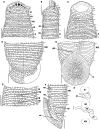Host-parasite relationships between seabirds and the haemadipsid leech Chtonobdella palmyrae (Annelida: Clitellata) inhabiting oceanic islands in the Pacific Ocean
- PMID: 32943118
- PMCID: PMC10317757
- DOI: 10.1017/S0031182020001729
Host-parasite relationships between seabirds and the haemadipsid leech Chtonobdella palmyrae (Annelida: Clitellata) inhabiting oceanic islands in the Pacific Ocean
Abstract
The duognathous haemadipsid leeches of the genus Chtonobdella show a trans-oceanic distribution throughout the Indo-Pacific region. Although passive long-distance dispersal (LDD) of Chtonobdella leeches by birds has been suggested, little is known about the host-parasite relationships between avian hosts and Chtonobdella leeches. In the current study, we investigated Chtonobdella leech infestations of the eyes and other mucus membranes of migratory procellariiform seabirds, Pterodroma hypoleuca and Oceanodroma tristrami, captured at six locations in the Bonin Islands, Honshu and Okinawa Island, Japan. Analyses of the partial sequences of 18S rRNA, 28S rRNA, and mitochondrial cytochrome c oxidase subunit I (COI) and morphological examination of the specimens demonstrated that the Chtonobdella leeches belonged to Chtonobdella palmyrae, which is indigenous to Palmyra Atoll in the Northern Line Islands. A dominant COI sequence type was observed in samples from all six sites; therefore, C. palmyrae almost surely dispersed approximately 1000 km by infesting the eyes and mucus membranes of procellariiform seabirds. The host-parasite relationships between procellariiform seabirds and C. palmyrae provide explicit evidence of the LDD of duognathous haemadipsid leeches. The taxonomic status of Haemadipsa zeylanica ivosimae from the Volcano Islands is also briefly discussed.
Keywords: Avian host; Haemadipsidae; Hirudiniformes; blood-feeding; migration; overseas dispersal.
Conflict of interest statement
None.
Figures





Similar articles
-
A new subspecies of Trypanosoma cyclops found in the Australian terrestrial leech Chtonobdella bilineata.Parasitology. 2021 Sep;148(10):1125-1136. doi: 10.1017/S0031182021000639. Epub 2021 Apr 12. Parasitology. 2021. PMID: 33843511 Free PMC article.
-
Molecular Identification of Haemadipsa rjukjuana (Hirudiniformes: Haemadipsidae) in Gageo Island, Korea.Korean J Parasitol. 2014 Apr;52(2):169-75. doi: 10.3347/kjp.2014.52.2.169. Epub 2014 Apr 18. Korean J Parasitol. 2014. PMID: 24850960 Free PMC article.
-
Molecular detection of Bartonella spp. in terrestrial leeches (Haemadipsa rjukjuana) feeding on human and animal blood in Gageo-do, Republic of Korea.Parasit Vectors. 2016 Jun 7;9(1):326. doi: 10.1186/s13071-016-1613-3. Parasit Vectors. 2016. PMID: 27267358 Free PMC article.
-
[The leech--use in animals].Schweiz Arch Tierheilkd. 2001 Oct;143(10):516-7. Schweiz Arch Tierheilkd. 2001. PMID: 11680913 Review. German. No abstract available.
-
Molecular crosstalk in host-parasite relationships: schistosome- and leech-host interactions.Parasitol Today. 2000 Dec;16(12):536-40. doi: 10.1016/s0169-4758(00)01787-7. Parasitol Today. 2000. PMID: 11121852 Review.
Cited by
-
Ocular infestation by a juvenile leech, Myxobdella sinanensis in Japan.Am J Ophthalmol Case Rep. 2022 Feb 3;25:101389. doi: 10.1016/j.ajoc.2022.101389. eCollection 2022 Mar. Am J Ophthalmol Case Rep. 2022. PMID: 35198813 Free PMC article.
-
The potential of aquatic bloodfeeding and nonbloodfeeding leeches as a tool for iDNA characterisation.Mol Ecol Resour. 2022 Feb;22(2):539-553. doi: 10.1111/1755-0998.13486. Epub 2021 Sep 1. Mol Ecol Resour. 2022. PMID: 34402209 Free PMC article.
-
A new subspecies of Trypanosoma cyclops found in the Australian terrestrial leech Chtonobdella bilineata.Parasitology. 2021 Sep;148(10):1125-1136. doi: 10.1017/S0031182021000639. Epub 2021 Apr 12. Parasitology. 2021. PMID: 33843511 Free PMC article.
References
-
- Aizawa M and Morishima K (2018) Distribution of Haemadipsa japonica in Japan before the 1980s. Journal of the Japanese Forest Society 100, 65–69.
-
- Benham WB (1909) Preliminary report on two Hirudinea from the subantarctic islands of New Zealand. In Chilton C (ed.), The Subantarctic Islands of New Zealand. Reports on the Geo-Physics, Geology, Zoology, and Botany of the Islands Lying to the South of New Zealand, Based on Observations and Collections Made during an Expedition in the Government Steamer ‘Hinemoa’ (Captain J. Bollons) in November, 1907, Vol. 1. Wellington: Philosophical Institute of Canterbury, pp. 372–376.
-
- Boles W (2020) Eastern yellow robin (Eopsaltria australis), version 1.0. In del Hoyo J, Elliott A, Sargatal J, Christie DA and de Juana E (eds), Birds of the World. Ithaca, NY, USA: Cornell Lab of Ornithology. 10.2173/bow.yelrob1.01 (Accessed 16 July 2020). - DOI
-
- Borda E (2006) A revision of the Malagabdellinae (Arhynchobdellida: Domanibdellidae), with a description of a new species, Malagabdella niarchosorum, from Ranomafana National Park, Madagascar. American Museum Novitates 3531, 1–13.
-
- Borda E and Siddall ME (2011) Insights into the evolutionary history of Indo-Pacific bloodfeeding terrestrial leeches (Hirudinida: Arhynchobdellida: Haemadipisidae). Invertebrate Systematics 24, 456–472.

